Intro to OT
1/72
Earn XP
Description and Tags
Semester 1
Name | Mastery | Learn | Test | Matching | Spaced |
|---|
No study sessions yet.
73 Terms
Quantitative
Observable, measurable facts that can be discovered to explain and predict phenomena
Qualitive
Subjective experiences, socially constructed, complex, constantly changing
Discipline Paradigms
A discipline is a group of like-minded individuals concerned with understanding particular phenomena
Each discipline has a way of knowing and viewing the world
Individual lens
Paradigms change & evolve as understanding increases
Occupation & Meaning
Meaning is important
Linked to OT in regards to participation/engagement
Meaning is subjective and individual
Habits & Routines
Habits = relatively automatic things a person thinks or does repeatedly
Routines = the patterns we follow regularly. Type of higher order habit that involves sequencing & combining processes, procedures, steps and occupations.
Structures our time
Helps us organise our lives (efficiency, confidence, speed, experience)
Certain habits & routines are necessary for wellbeing
Loss of routine – increased risk of physical or emotional disturbances
Occupational Analysis
Process of examining and occupation and identifying all constituent parts
Fundamental to OT
Various OT frameworks to guide this
Different terminology used
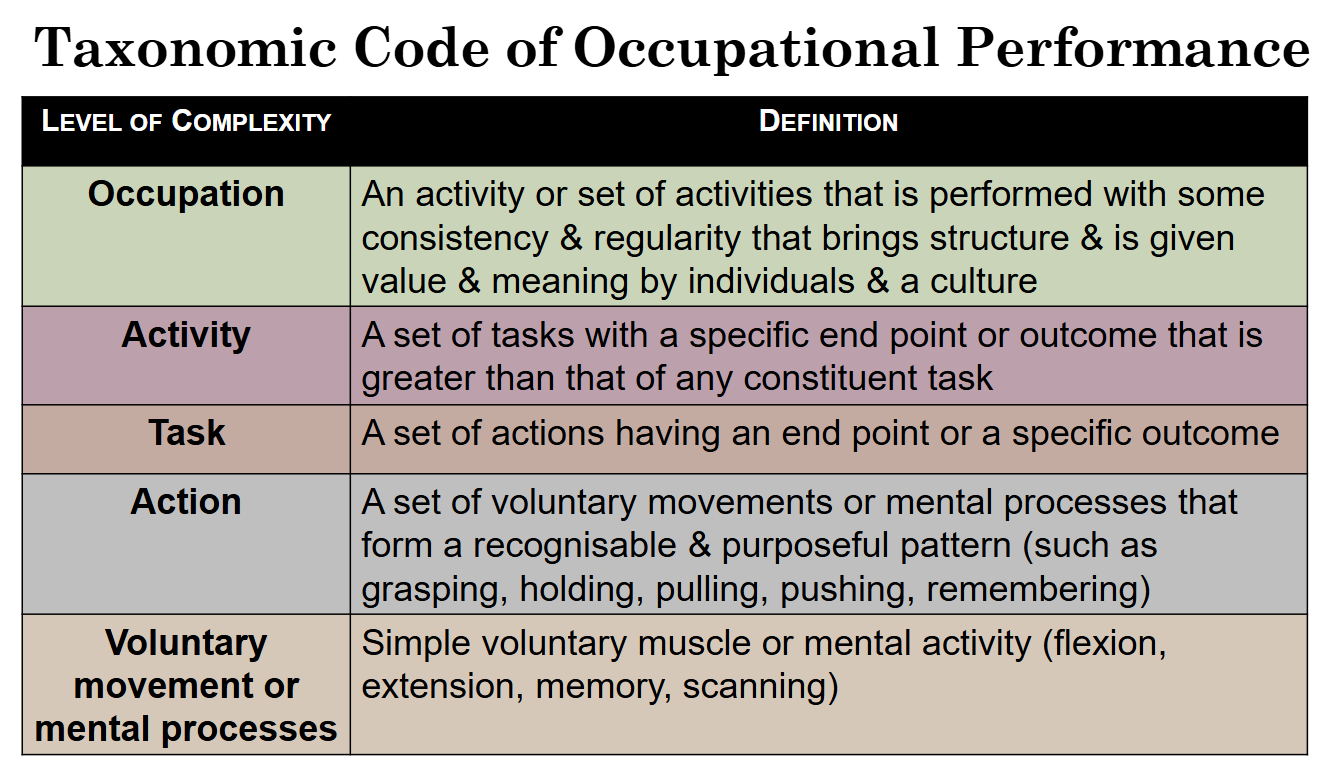
T - COP
T - Cop (Occupation)
Activities performed with some consistency & regularity & create structure
Given value and meaning by individuals and culture
Occupations should be ending in 'ing'
At any given time we must be doing something that can be considered our PRIMARY occupation
Activities and occupations can be performed simultaneously = embedded or secondary occupation
T-COP (Activity)
Numerous tasks make up activity
T-COP (Tasks)
Self-contained stage in an activity
A combination of actions sharing some purposes as recognised by the task performer, related to the accomplishment of specific goals

Hierarchy of Occupation
Classifying Occupations
Self-Care: everything people do to take care of themselves
Productivity - everything people do to contribute to the social and economic fabric of communities
Leisure - everything people do to enjoy life
Rest - the purposeful pursuit of non-activity
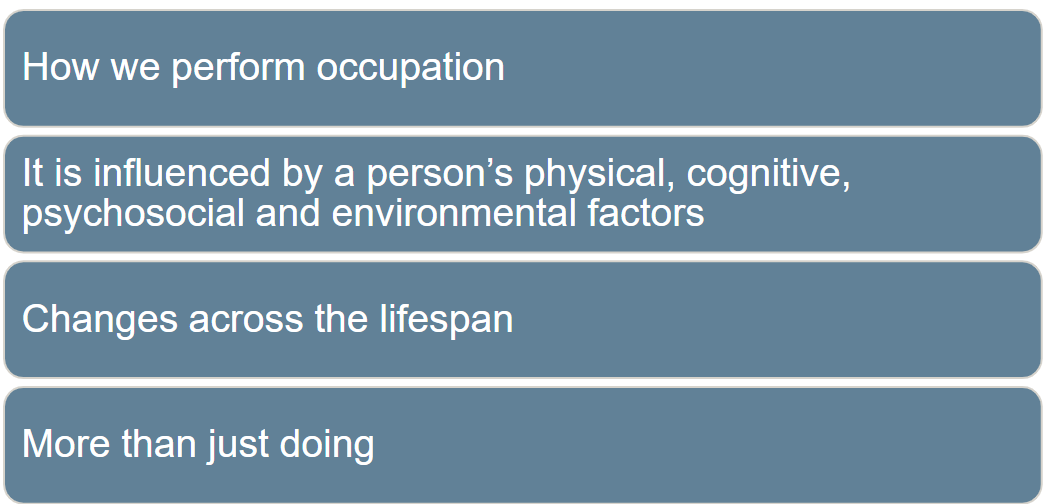
Occupational Performance
The ability to perceive, desire, recall, plan and carry out roles, routines, tasks and subtasks for purpose of self-maintenance, productivity, leisure and rest in response to demands of the internal
and/or external environment.
Defining Context
The 'where'
'context and environment' - interchangeable
Both physical and social elements
Social context – further divided
Understanding Context
Transactional nature – we shape and are shaped by the world around us
The person and their environment are intertwined and co-constitutive
Constantly influencing each other
Physical Context
Natural – all living and non-living things occurring naturally in the world
Built – buildings, products, technology
Space in between
Social Context
The complexities of our relationships, connections and influence of others in our world
Includes – relationships, attitudes and expectations of each other, social events and connections
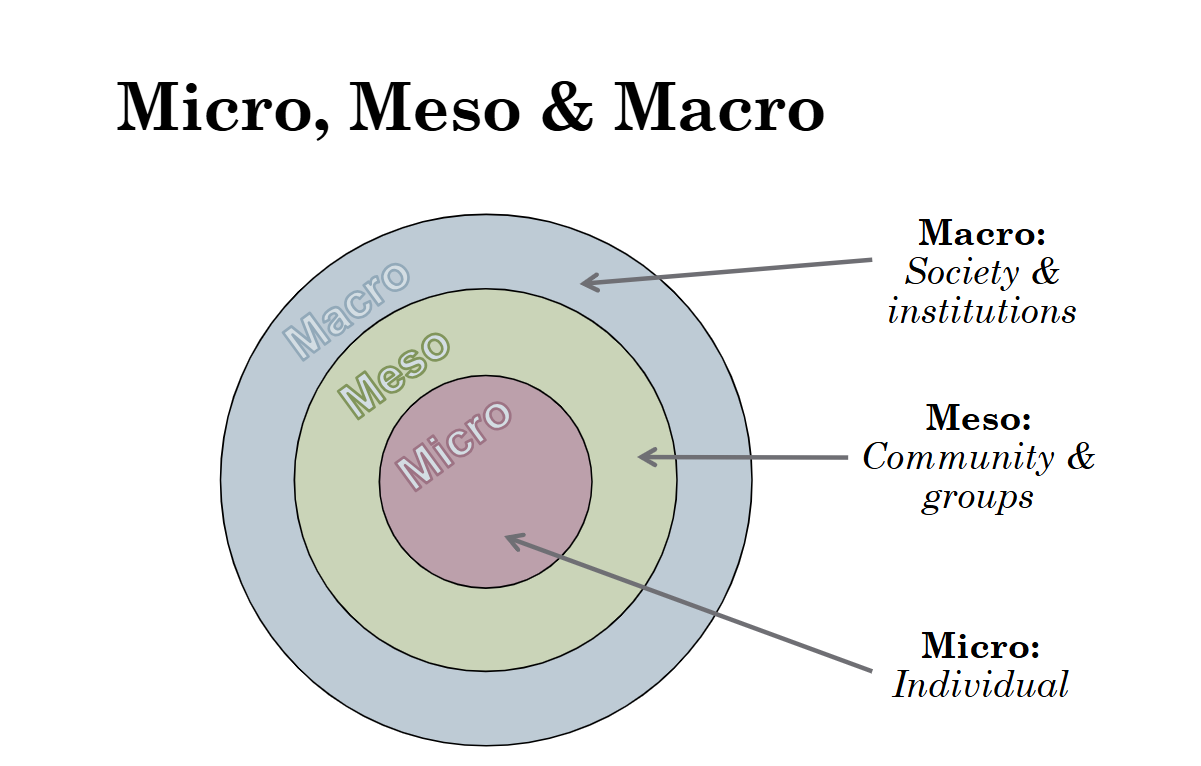
Understanding Social Context
Holistically
By layers: social systems and structures – social groups in relation to access to resources and power – micro, meso and macro elements
Institutional Context
Usually macro-level
"institutions" organise society socially, economically, politically, legally
Informal + formal structures for order and governing society
Highly complex + reflect societal values, power and resources
Has a profound effect on human occupation
The impact of human institutions is embedded in day-to-day life & is hard to identify
Institutional elements control policies that influence access to resources and services
Temporal Context
Our lives and the world we live in are not static
Temporal refers to time
Two main elements – cyclical and linear time
Cyclical – the routines and patterns in life – daily, weekly, yearly outcomes
Linear – past, present and future – influence of history and the experiences throughout the lifespan
Cultural Awareness
Understanding of the similarities & differences in attitudes, values, beliefs & customs between themselves & people from other countries or other backgrounds
Cultural Responsiveness
refers to the ability and willingness to recognise, respect and effectively respond to the diverse
cultural backgrounds, values, beliefs, and practices of individuals or communities.
Cultural Safety
“An environment, which is safe for people; where there is no assault, challenge or denial of their identity, of who they are and what, they need. It is about shared respect, shared meaning, shared knowledge and experience, of learning together with dignity, and truly listening”
Aspects of the Person - Physical
Physical traits
Physical function/performance/skills
Biological systems
Movement
Strength
Coordination
Balance
Sensation
Pain
Appearance
Illness/injury of body systems or structures
Aspects of the Person - Cognitive
'cognition'
'thinking'
'the mental process involved in knowing, learning, and understanding things
Acquiring knowledge
Memory
Orientation
Concentration
Insight
Judgement
General knowledge
Problem solving
Aspects of Person - Psychological
'affective'
'mental health'
'psychological and emotional well-being'
'intrapersonal'
Aspects of the Person - Intellectual
Ability to understand things and think in a logical way
This is important to consider when working with people with disability
Mood
Affects
Emotional regulation
Resilience
Confidence
Motivation
Influencing Factors - Intrinsic
Personality /temperament
Preferences
Skills, abilities, knowledge
Basic needs
Health/ illness/ disability
Biological rhythms
Age, gender, socio-economic status
Values, attitudes, meanings (spirituality)
Influencing Factors - Extrinsic
Physical, social, cultural, institutional contexts
Resources
Circumstance
Time
Space
Occupational Roles
Determined by each unique person-context- performance relationships
Established through need and/or choice
Roles are modified with age, ability, experience, circumstance and time
Roles are nouns
∙ I am a …Roles may be:
∙ Short term
∙ Long termRoles can overlap, be congruent or conflict –
affecting life balance and stress levelsInfluence behaviour
Chosen or assigned
Dynamic
‘Cultural norms’ influence
Variability – characteristics, circumstance & context

PEO - Person, Occupation, Environment
PEO Model- Examines relationship among person, environment and occupation and how this contributes to occupational performance
How this contributes to occupational performance is called PEO-fit
PEO-fit changes over time and with different circumstances
Transactive rather than interactive
Health & Wellbeing
Health is the state of being free from illness and injury
The condition of being sound in body, mind or spirit
A balance between four bodily fluids – black bile, yellow bile, phlegm, and blood
Harmonious functioning of the organs
The ‘Negative’ View of Health
Health is seen as the absence of illness
Health is defined by reference to ill health
Health is defined by what it is NOT:
Not experiencing symptoms, not suffering any serious sickness/pain, not being ill
The ‘Positive’ View of Health
a state of being
Describing what you have that constitutes health
Example – being fit/functional, having energy, having healthy habits
An organism that is working well as a whole
A state of equilibrium or wellness
Social Determinants
Non-medical factors that influence health outcomes
The conditions in which people are born, grow, work, live, and age and the wider set of forces and systems shaping the conditions of daily life
Determinants Include:
Income and social protection
Education
Working for life conditions
Food insecurity
Structural conflict
Early childhood development
United Nations adds that self-determination, collective rights, crucial to indigenous health
Health Promotion
the process of enabling people to increase control over, and to improve their health
Central document in world health policy
Bio-pyscho-social view of health
Health is a positive concept – requiring personal & social resources and the ability to cope with the environment
Calls for health services & societies to act beyond the medical treatment of disease

Biopsychosocial Model
Health Promotion
The process of enabling people to increase control over, and to improve their health knowing that lifestyle & occupational choices influence both physical and psychological wellbeing
Saluto Genesis
The study of the origins of health and focuses on factors that support human health and wellbeing, rather than on factors that causes disease
What creates health
What supports health vs what causes disease
Occupational Balance
A state of equilibrium or equipoise; equal distribution
Happiness is not a matter of intensity but of balance and order and rhythm and harmony
Humans have many roles and occupations
Complementary/competing
Fluidity in balance
Includes 6 factors; individual, subjective, experienced, changes over time, does not mean equal distribution, no 'ideal' distribution
Occupational Imbalance
Lack of congruence across occupations or between occupations and one's core values
Can be due to over occupation or under occupation
PEO Elements - Person
Dynamic, motivated and ever-developing being
Constantly interacting with the environment
People change over time – this may stem from changes to the environment, circumstances or development
PEO Elements - Environment
Conceptualised as inseparable from the person
Model processes that the environment both shapes and is shaped by people
Five aspects – cultural, socioeconomic, institutional, physical, social
Context/environment shapes/influences occupational performance
PEO Elements - Occupation
What people do in the environment
Three aspects of occupation – task, activity, occupation
'nestled within each other’
PEO Elements - Occupational Performance
"The dynamic results of the transaction between the person, environment and occupation is known as occupational performance"
Measured both subjectively and objectively
PEO-fit
Based on the premise that the person, environment and occupation interact regularly over time and space
The better the fit or compatibility between the person, environment and occupation, then the greater the occupational performance
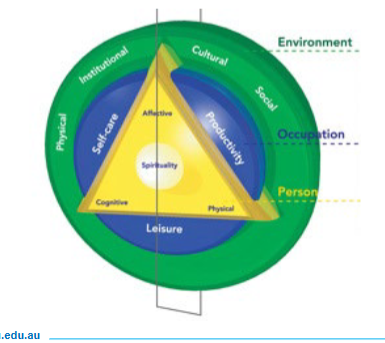
CMOP - E Historical Developments
A group of OT, medical and medical sociology colleagues work on a project to articulate the conceptual foundations of OT in Canada
Guidelines for client-centred practice for OT
Intervention guidelines for client-centred practice of OT
Toward outcomes measures in OT
The Occupational Performance Model
CMOP
Presented in 1997 as a new version of the OPM
Three dimensional
Emphasises the dynamic nature of the interaction of the PEO
Occupational performance if embedded within the model
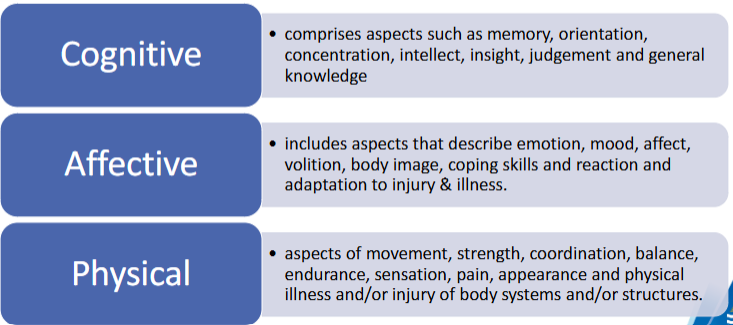
CMOP - E (Key Elements - Person)
Spirituality is a separate component situated at the core of the entire model
Spirituality is infused within the person
The CAOT (1997) characterizes spirituality as ‘a pervasive life force,
manifestation of a higher self, source of will and self-determination, and a sense of meaning, purpose and connectedness that people experience within the context of their environment’
CMOP - E (Key Elements - Environment)
Physical – all natural & built aspects of the environment
Social – people in the environment, relationships, networks and assistance
Cultural – includes personal & family rituals, expectations & attitudes of broader culture
Institutional – government & organisational structure, education, unemployment race
CMOP - E: Concept of Occupation
Occupational performance is only one aspect of a person's potential engagement in occupation
People have many occupations
CMOP - E (Occupational Repertoire)
Presents an idea of a person's occupational life
Broadens scope to consider occupational balance/imbalance, marginalisation and deprivation
CMOP - E (Performance)
Captures what a person has capacity, skills & knowledge to do
Observable act of 'doing'
Embedded in the model where occupation bridges person & environment
Taxonomic Code of Occupational Performance (TCOP) offers a way of understanding the observable acts of doing
CMOP - E (Engagement)
This is a distinct important outcome for OT
There needs to be involvement in the 'doing'
Broadens scope to include social participation in occupation
Key Assumptions regarding Occupation
Occupation affects health and well-being
Occupation organises time ad brings structure to living
Occupation brings meaning to life
Occupations are idiosyncratic
Summary: CMOP - E
The CMOP – E as developed over time to reflect concepts central and core to occupational therapy practice
Key elements of the person, occupation and the environment are considered
The core domain of OT is visualised in the model
Occupational engagement has broadened the scope of OT to go beyond just the 'doing', and to consider the subjective experience and motivations of occupation
There are many guiding frameworks and resources to compliment CMOP – E and occupation therapy practice
Model of Human Occupation - History of MOHO
One of the first published OT models of practice
Developed by Dr Gary Kielhofner
First published in 1980 with adaptations
Very important model, one of the most influential theoretical contributions to OT
Understanding human occupation requires the application of systems theory and demands the application of research the biological, psychological and social sciences
MOHO seeks to explain occupational behaviour, it helps in understanding how occupation is motivated, patterned and performed
Key Elements of MOHO
Three interrelated components of the person
Volition
Habituation
Performance capacity
Environmental context
Three dimensions of doing
Occupational skill
Occupational performance
Occupational participation
Occupational adaptation
Occupational identity
Occupational competence
Volition - MOHO
A pattern of thoughts and feelings about oneself as an actor in one's world which occurs as one anticipates, chooses, experiences, and interprets what one does
Subcomponents
Personal causation
Values
Interest
Habituation - MOHO
Subsystem responsible for organising behaviour into routines or patterns
Subcomponents
Habits
Roles
Performance Capacity - MOHO
The ability to do things
Subcomponents
Objective components (physical and mental abilities)
Subjective components (the lived body)
Environment - MOHO
The particular physical and social, cultural, economic and political features of one's contexts that impact upon the motivation, organisation and performance of occupation
Subcomponents
Spaces
Objects
Social groups
Occupational forms
Cultural, political and economic context
Three Dimensions of Doing
Occupational participation – engaging in work, play or activities of daily living that are part of one's sociocultural context and that are desired and/or necessary to one's wellbeing
Occupational performance – the doing of an occupation
Occupational skill: the skills required to perform the occupation
Motor – moving self or objects
Process – sequencing actions
Communication and interaction - (communicating needs and intentions + engaging with others)
KAWA Model History & Overview
The Kawa Model is a therapeutic method developed in Japan
Kawa is the Japanese word for 'river'
Uses the natural metaphor of a river to depict one's life journey
Quality and character of its flow will vary from place to place, from instance to instance
Can be used as a conceptual model of practice, frame of reference, assessment tool and modality

KAWA Model
(I) life flow and overall occupations (river)
(ii) environments/contexts, social and physical (river banks)
(iii) circumstances that block life flow and cause dysfunction/disability (rocks)
(iv) personal resources that can be assets or liabilities (driftwood)
Elements of KAWA Model
River
the past, present and future occupational needs of the client
The flow of a person's life
River banks:
Natural contexts, including social and physical environments
A person exists and interacts with others
Rocks:
Barriers to function and life flow
Life issues that are usually deep-rooted and can impact water flowing through river
Driftwood
Assets and resources that promote function and happiness
What people use to their advantage
History of OPM(A)
First published 1986 – Sydney, Australia
Founded on the Occupational Performance Model, the focus of OT movement in the 70s and 80s
By the 1990s – sent it on a broader and more deeply contextualised notion of occupational performance
Key Assumptions of OPM(A)
OT -> occupational needs
Satisfaction with occupational experience
Strategies to enhance occupational performance
Occupational performance - "the ability to perform, including doing knowing and being dimensions"
Occupations are those activities and tasks that a person:
Wants to do
Needs to do
Capable of doing
Key Elements OPM(A) - Occupational Role
Determined by individual person-environment-performance relationships
Established through need and/or choice
Modified with age, ability, experience, circumstance and time
Roles connect the internal and external environments
3 dimensions:
Doing – how we carry out these roles
Knowing – understanding desired or expected roles
Being - the satisfaction or fulfilment that a person might obtain from them
Key Elements OPM(A) - Performance Areas
Patterns of occupational behaviour are grouped into performance areas
Productivity – occupations/routines that enable a person to provide support for self, family or community through the production of goods or provision of services
Self-maintenance: occupations to preserve a person's health and well-being in the environment
Leisure: entertainment, creativity and celebration
Rest: the purposeful pursuit of non-activity
Key Elements OPM(A) - Performance Components
Attributes of the performer as well as the components of the occupation
Biomechanical: operation/interaction between physical structures of the body, or the biomechanical attributes of the task
Sensory-motor: operation/interaction between sensory input and motor responses of the body, or the sensory aspects of the task
Cognitive: operation/interaction between mental processes, the cognitive dimensions of the task (simplicity or complexity)
Intrapersonal: interaction between internal psychological processes (emotions, mood, self-esteem)
Interpersonal: the continuing and changing interaction between a person and others
Key Elements OPM(A) - Core elements
'Core elements of human existence'
Body: all of the tangible physical components of human structure
Mind: core of our conscious and unconscious intellect that forms the basis of our ability to understand and reason
Spirit: sense of harmony within self and between self, nature, others and in some cases an ultimate other
Key Elements OPM(A) - Environment
Both internal and external; below are external
Physical: the natural and constructed surroundings
Sensory: the sensory surroundings of a person
Cultural: an organised structure composed of a systems of vales, beliefs, ideals and customs which contribute to the behavioural boundaries of a person or group of people
Social: an organised structure created by the patterns of relationships between people who function in a group which in turn to establishing the boundaries of behaviour
Environment Cont.
Physical
Sensory
Cultura
Social
Economic
Political